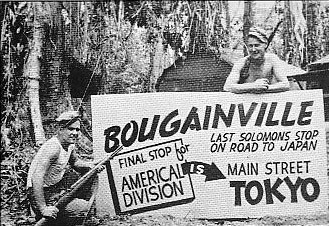|
Torokina revisited
 Photo taken by the US Army Signal Corps during the American
occupation of Torokina, shows two members of the American
Division (Private Alva Griffin of Madison, Illinois, and
T/5 Henry Kutzer of Chicago) standing next to a sign with
a self-explanatory message.
Photo taken by the US Army Signal Corps during the American
occupation of Torokina, shows two members of the American
Division (Private Alva Griffin of Madison, Illinois, and
T/5 Henry Kutzer of Chicago) standing next to a sign with
a self-explanatory message.
Torokina, about halfway up Bougainville's west coast, means little island in the local "tok ples". The name refers to the islet lodged between Puruata Island and the mainland where Banoni Mission stands. In 1910 European contact began in the shape of the Marist missionary, Father Leon Chaize, who founded a mission there. This was how things stood until the US invasion of Bougainville when Torokina became one of the most famous battle spots of the Pacific War. The Japanese, in strength at Buka and Buin, had not expected the Americans to land on the surfswept beaches of Empress Augusta Bay. When 7,000 American Marines began landing on November 1941, 1943, they were resisted by only 270 Japanese at Cape Torokina and a platoon on Puruata. Nevertheless 78 marines were killed and 104 wounded by accurate machine gun fire from 18 pillboxes and 75 mm gun, before the Japanese were killed or driven inland. The Americans wanted Torokina for a special reason: it was within bomber distance of Rabaul. Immediately after the landing, engineers searched for adequate sites for airstrips. The first, along the coast, was constructed and opened on December 9 - an astounding achievement. Two others, further inland were opened shortly after. The Japanese airstrips on Bougainville had been knocked out shortly before the US attack. When they opened again, planes began systematically attacking the Torokina beachhead. Surprisingly, few Americans were killed in these attacks, mainly because the Japanese preferred to attack at night. It was not until the Americans were firmly entrenched that the Japanese under General Hyakutake realised that there was to be no attack on Buin or Buka. In mid-February the next year the Japanese counter-attacked. Before that time a Fijian battalion under New Zealand officers had been doing sterling work observing the Japanese positions at Wakunai from Ibu village in the mountains. They retreated back over the Numa Numa Trail as the Japanese attack began. Some 20,000 Japanese were believed to have been involved in the attack. When the fighting was over, the Americans had held Torokina for the loss of 203 dead. The Japanese had lost over 5,000 men and 3,000 wounded. It was their last offensive in the Solomons. From then on both sides were content to hold their positions. In October 1944 the Americans were relieved by Australian forces. They had not extended their control beyond the plains around Torokina. The Australians began a more aggressive campaign, slowly extending their control northwards towards Buka, south towards Buin and east across the Numa Numa Trail. They were only robbed of a major confrontation with the Japanese by the enemy's surrender. Soon after the war salvage operators moved in and began clearing the thousands of tons of war materials abandoned by the Allies. Today Torokina is virtually bare of war debris. There are a number of rotting troop carriers near the radio repeater station and a few bits and pieces deep in the bush. The remains of the airstrips can be clearly seen from the air but are covered in long grass or coconuts on the ground. The coastal airstrip is largely taken over by the rebuilt Banoni Mission. In the bush, not far from the Piva Leper Hospital, is a small concrete memorial to Americans who died during the war. When the jungle vines are cleared an inscription reads
Since the war Torokina has been cut off from the outside world. The occasional ship visits and people come and go along the trails from Wakunai and long the coast. But the wartime road and airstrip system has all but disappeared. Until now that is. At this very moment a private contractor is renovating one of the inland airstrips and in a few months' time people will be able to visit this very scenic spot. At present however there is no hotel or guest house. Courtesy PANGUNA-The Voice of Bougainville Copper |
